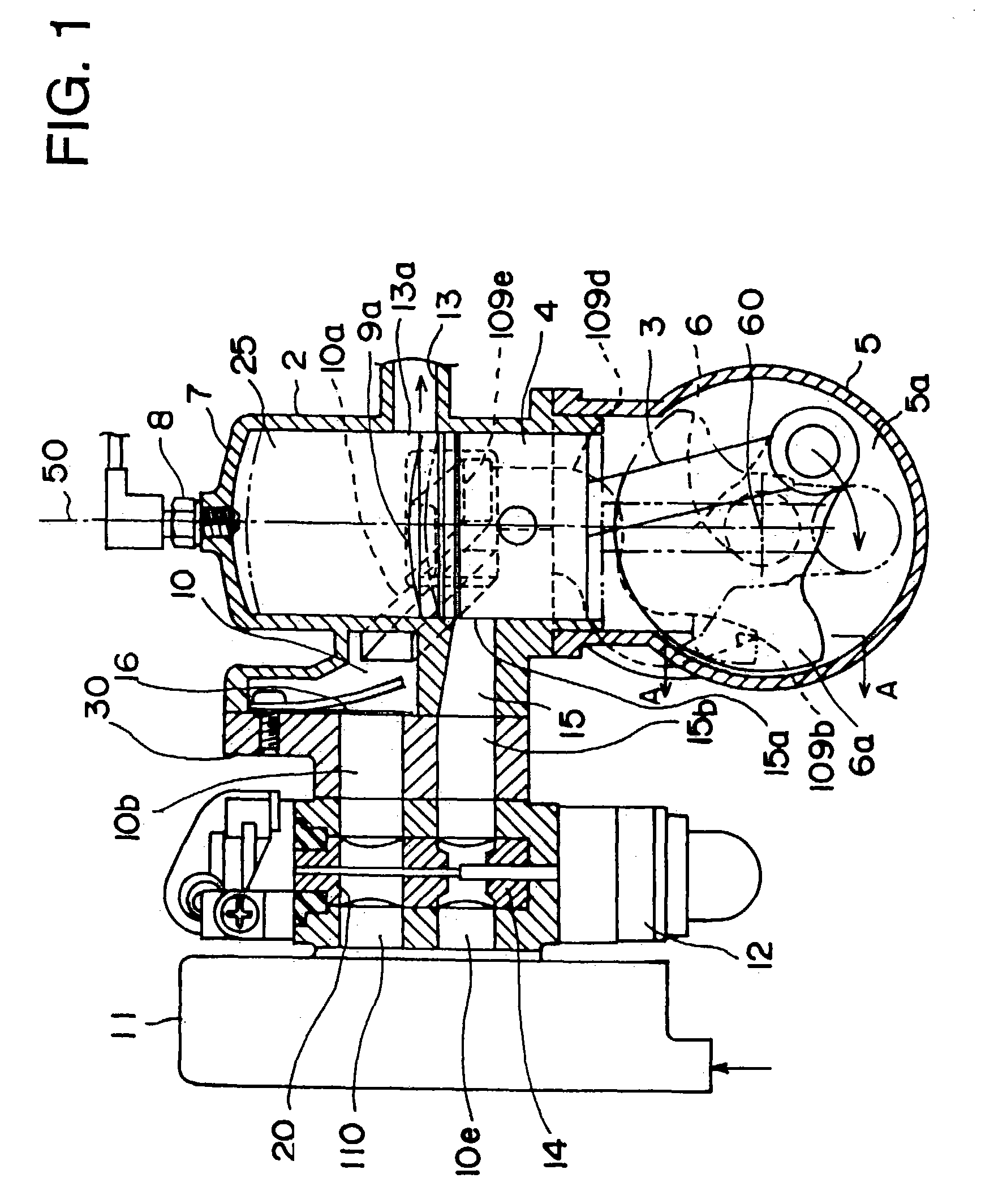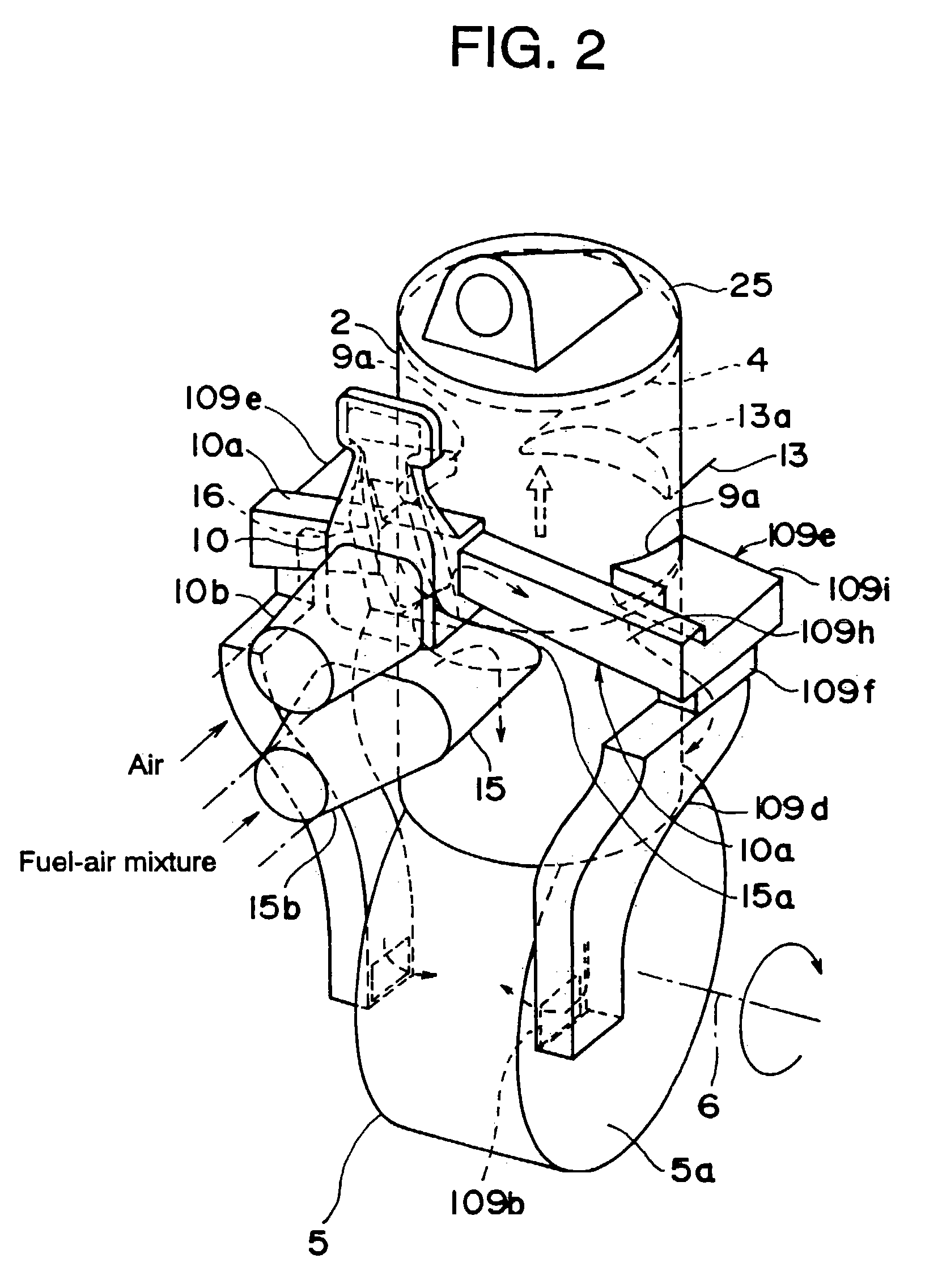Two-stroke cycle engine
a two-stroke cycle engine and cycle technology, applied in the direction of combustion air/fuel air treatment, machines/engines, fuel air intakes, etc., can solve the problems of fuel wastage, increased cost, and the airflow supplied through the supply passage during scavenging not being controlled to conform to the operating state of the engine, so as to reduce the quantity of fuel-air mixture, reduce fuel wastage, and simple shape
- Summary
- Abstract
- Description
- Claims
- Application Information
AI Technical Summary
Benefits of technology
Problems solved by technology
Method used
Image
Examples
first embodiment
[0243]FIGS. 6 through 8 show the second preferred embodiment of a preceding air layer-type scavenging two-stroke engine according to this invention. In this embodiment, the air control valve 20 of the two-stroke engine of the first embodiment is replaced by a modified valve 20 which has the following improvements.
[0244]In FIGS. 6 through 8, 11 is the air cleaner, 12 the carburetor, 10e the air passage in carburetor 12, and 14 the fuel mixture control valve of carburetor 12. 15 and 15b are the fuel mixture passages, and 15a is the supply inlet for the fuel mixture on cylinder 2.
[0245]20 is the air control valve. 45 is an air pipe connecting the air passage 10e of the air cleaner 11 to a separate outlet. 35 is the air supply pipe in the insulator attached to the cylinder 2. 36 is a joint pipe for intake air. It is attached to air supply pipe 35 in the insulator and connected to the outlet of the air passage 110.
[0246]As is shown in FIG. 7, the scavenging air, which is conducted throug...
second embodiment
[0263]Control lever 124 is fixed to the rotary stem of mixture control valve 14 on the carburetor 12. On the end of control lever 124, in contrast to the configuration of the second embodiment, is portion 127c, which is bent upward. This forms internal cam 127a, whose horizontal cross section is fan-shaped. The internal cam 127 is interlocked with cam follower 38 of air valve 37 so that it opens and closes that air valve. The internal cam 127a is installed so that it opens air valve 37 through the action of cam follower 38 in the direction opposite the air flow, i.e., in the direction in which it exerts pressure on compressive spring 41.
[0264]Other aspects of the configuration and operation of this engine are identical to corresponding aspects of the second embodiment, and have been given the same numbers.
[0265]FIGS. 12 through 18 show the fourth preferred embodiment of this invention. In this embodiment, the respective supply systems for the preceding air and the fuel mixture have ...
fourth embodiment
[0283]In the fourth embodiment, the air passage 10b and fuel-mixture passage 15 are connected either by small-diameter connecting passages 43 and 44 in insulator gasket 41 and carburetor gasket 42 or by slits 47 and 51, which are cut into insulator 30. When the engine is idling, then, the fuel-air mixture in fuel passage 15 goes through either small-diameter connecting passages 43 and 44 or slits 47 and 51 into air passage 10b and air supply chamber 10.
[0284]Thus when there is too much air in air passage 10b during sudden acceleration, fuel-air mixture can be added to the air flowing through air passage 10b. This prevents the new air being supplied to combustion chamber 25 via scavenging port 9a from causing there to be excess air in the chamber. It thus also prevents the fuel concentration from becoming too thin during sudden acceleration and so improves the engine's acceleration characteristics.
[0285]When the engine is running at a high speed, the throttle is opened more, and the ...
PUM
 Login to View More
Login to View More Abstract
Description
Claims
Application Information
 Login to View More
Login to View More - R&D
- Intellectual Property
- Life Sciences
- Materials
- Tech Scout
- Unparalleled Data Quality
- Higher Quality Content
- 60% Fewer Hallucinations
Browse by: Latest US Patents, China's latest patents, Technical Efficacy Thesaurus, Application Domain, Technology Topic, Popular Technical Reports.
© 2025 PatSnap. All rights reserved.Legal|Privacy policy|Modern Slavery Act Transparency Statement|Sitemap|About US| Contact US: help@patsnap.com



